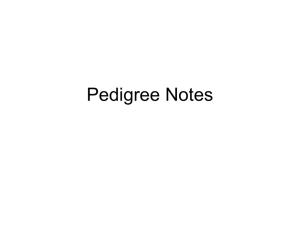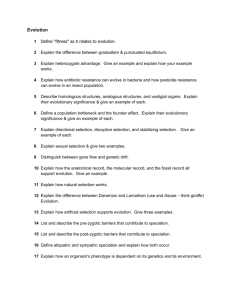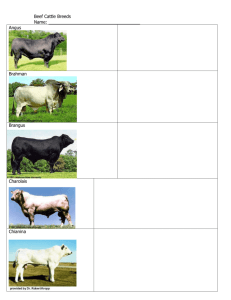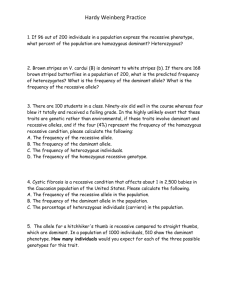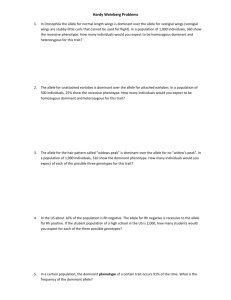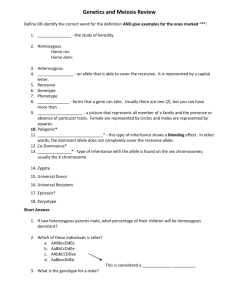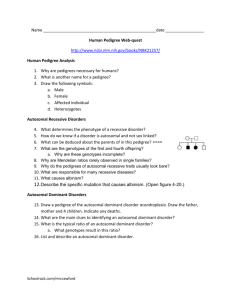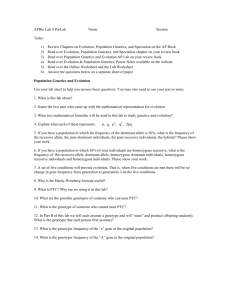phenotype chromosomal
advertisement
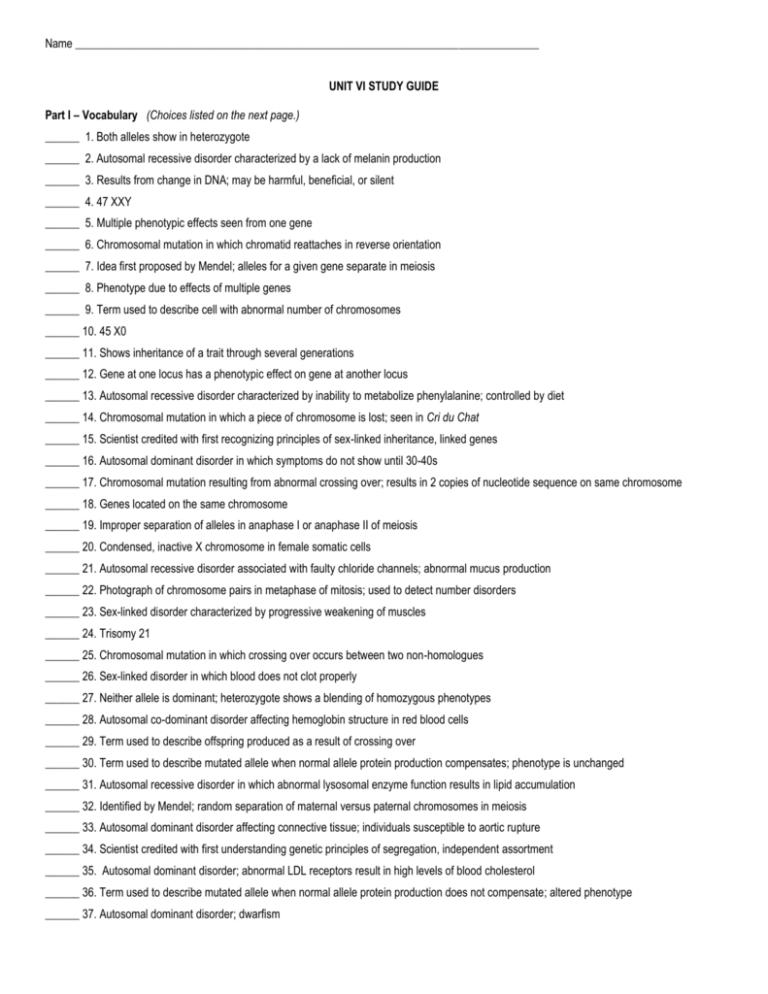
Name _________________________________________________________________________________ UNIT VI STUDY GUIDE Part I – Vocabulary (Choices listed on the next page.) ______ 1. Both alleles show in heterozygote ______ 2. Autosomal recessive disorder characterized by a lack of melanin production ______ 3. Results from change in DNA; may be harmful, beneficial, or silent ______ 4. 47 XXY ______ 5. Multiple phenotypic effects seen from one gene ______ 6. Chromosomal mutation in which chromatid reattaches in reverse orientation ______ 7. Idea first proposed by Mendel; alleles for a given gene separate in meiosis ______ 8. Phenotype due to effects of multiple genes ______ 9. Term used to describe cell with abnormal number of chromosomes ______ 10. 45 X0 ______ 11. Shows inheritance of a trait through several generations ______ 12. Gene at one locus has a phenotypic effect on gene at another locus ______ 13. Autosomal recessive disorder characterized by inability to metabolize phenylalanine; controlled by diet ______ 14. Chromosomal mutation in which a piece of chromosome is lost; seen in Cri du Chat ______ 15. Scientist credited with first recognizing principles of sex-linked inheritance, linked genes ______ 16. Autosomal dominant disorder in which symptoms do not show until 30-40s ______ 17. Chromosomal mutation resulting from abnormal crossing over; results in 2 copies of nucleotide sequence on same chromosome ______ 18. Genes located on the same chromosome ______ 19. Improper separation of alleles in anaphase I or anaphase II of meiosis ______ 20. Condensed, inactive X chromosome in female somatic cells ______ 21. Autosomal recessive disorder associated with faulty chloride channels; abnormal mucus production ______ 22. Photograph of chromosome pairs in metaphase of mitosis; used to detect number disorders ______ 23. Sex-linked disorder characterized by progressive weakening of muscles ______ 24. Trisomy 21 ______ 25. Chromosomal mutation in which crossing over occurs between two non-homologues ______ 26. Sex-linked disorder in which blood does not clot properly ______ 27. Neither allele is dominant; heterozygote shows a blending of homozygous phenotypes ______ 28. Autosomal co-dominant disorder affecting hemoglobin structure in red blood cells ______ 29. Term used to describe offspring produced as a result of crossing over ______ 30. Term used to describe mutated allele when normal allele protein production compensates; phenotype is unchanged ______ 31. Autosomal recessive disorder in which abnormal lysosomal enzyme function results in lipid accumulation ______ 32. Identified by Mendel; random separation of maternal versus paternal chromosomes in meiosis ______ 33. Autosomal dominant disorder affecting connective tissue; individuals susceptible to aortic rupture ______ 34. Scientist credited with first understanding genetic principles of segregation, independent assortment ______ 35. Autosomal dominant disorder; abnormal LDL receptors result in high levels of blood cholesterol ______ 36. Term used to describe mutated allele when normal allele protein production does not compensate; altered phenotype ______ 37. Autosomal dominant disorder; dwarfism A. achondroplasia B. albinism C. aneuploid D. Barr body E. co-dominance F. cystic fibrosis G. deletion H. dominant I. Down Syndrome J. Duchenne muscular dystrophy K. duplication L. epistasis M. hemophilia N. Huntington’s disease O. hypercholesterolemia P. incomplete dominance Q. inversion R. karyotype S. Klinefelter Syndrome T. Law of Independent Assortment U. Law of Segregation V. linked genes W. Marfan syndrome X. Mendel Y. Morgan Z. mutation AA. nondisjunction BB. pedigree CC. PKU DD. pleiotropy EE. polygenic FF. recessive GG. recombinant HH. sickle cell anemia II. Tay-Sachs disease JJ. translocation KK. Turner Syndrome Part II - Word Problems 1. An infant with type A blood is born to a mother that is type O blood. What are the possible genotypes for the father? 2. If a parent has the genotype, AAbbCcDd, identify the different gametes that might be produced and the probability of each occurring. 3. Polydactyly (extra fingers & toes) is due to a dominant allele. A father is polydactyl, the mother has the normal phenotype, and they have had one normal child. What is the probability that a second child will have the normal number of digits? 4. White fruit color in summer squash is governed by a dominant allele (W) and colored fruit by its recessive allele (w). There are two possibilities for the colored fruit, yellow (Y) and green (y). a. For the cross, Wwyy X WwYY, what is the probability of yellow fruit? b. For the cross, WwYy X green, determine the expected phenotype ratio. 5. Refer to the pedigree below showing the incidence of color blindness in three generations of a family. Provide the genotype(s) of the indicated individuals. A ____________ B ____________ C ____________ Could this pedigree represent any other path of inheritance? Of the disorders we’ve discussed, list all realistic possibilities for this pedigree. D ____________ 6. Bronze turkeys have at least one dominant allele, R. Red turkeys are homozygous for its recessive allele, rr. Another dominant gene H produces normal feathers, and its recessive genotype hh produces feathers lacking webbing, a condition termed “hairy”. In crosses between true-breeding bronze, hairy birds and true-breeding red, normal-feathered birds, what proportion of the F2 progeny will be a. Rrhh b. bronze, hairy c. RrHh d. bronze, normal-feathered 7. A genetic condition on the X chromosome in Drosophila melanogaster is lethal when homozygous in females or hemizygous in males, but when heterozygous in females produces a purple eye color called “plum”. The other homozygous condition produces wild type eye color. On chromosome 3, a gene produces short, stubble bristles when homozygous and wild type bristles when heterozygous. A plumeyed female homozygous dominant for bristles is crossed with a male with wild type eyes and heterozygous for bristles. What are the expected phenotype ratios? 8. The locus for pink eyes in Drosophila melanogaster is on the same chromosome as the locus for wrinkled wings. The wild type phenotype is dominant for both genes. In a test cross using dihybrid flies, the following offspring are observed 676 wt eyes, wt wings 623 pink eyes, wrinkled wings 124 wt eyes, wrinkled wings 108 pink eyes, wt wings How many map units separates the two loci described above? 9. In corn, the genes for kernel color and kernel texture are unlinked. Purple kernels are dominant to yellow kernels; smooth kernels are dominant to wrinkled kernels. In a dihybrid cross, the following offspring are observed, 261 purple and smooth, 79 purple and wrinkled, 65 yellow and smooth, and 21 yellow and wrinkled. Use Chi Square to determine if these numbers are within acceptable limits. 10. Given the following information, draw the chromosome showing correct placement of the genes A, B, C, D, and E. A – B = 8 map units B – C = 10 map unitis A – C = 18 map units B – D = 22 map units C – D = 32 map units C – E = 30 map units D – E = 2 map units
